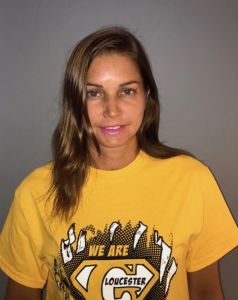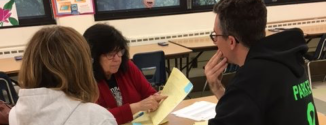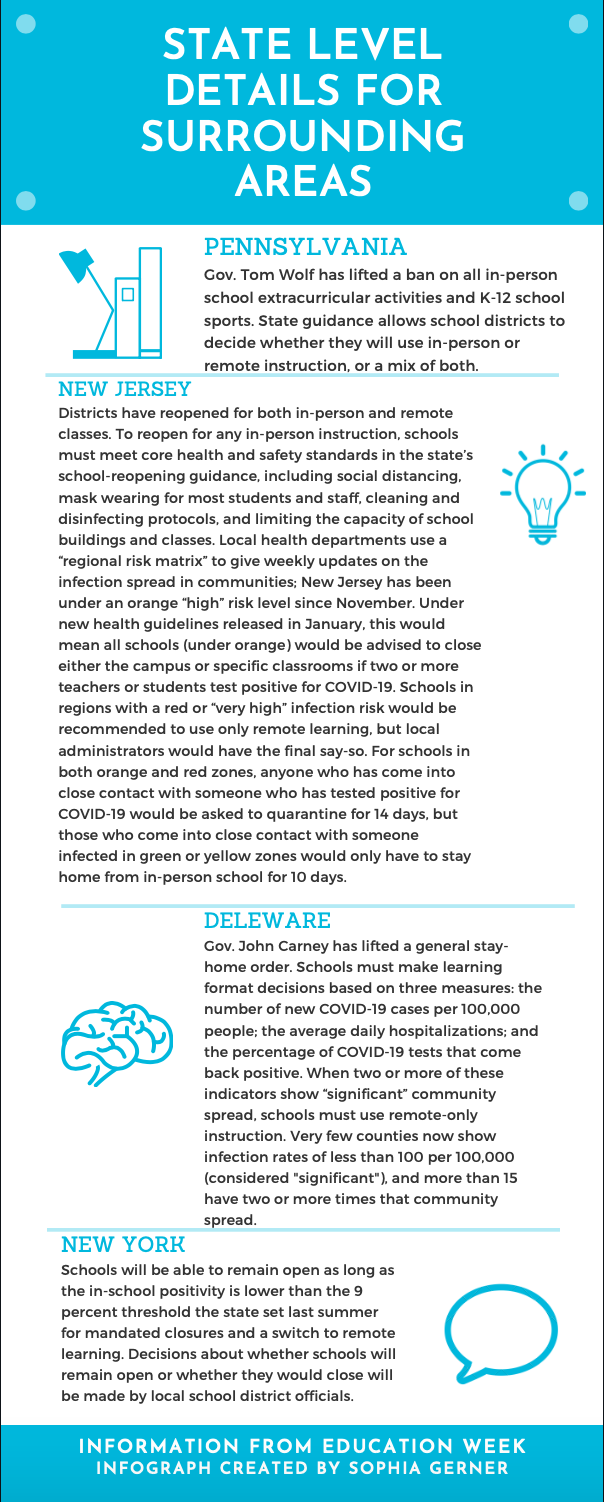While working during her teen years with a child who has a disability, Maria Maiorano discovered her passion for special education. From that moment forward, she knew this was a cause worth fighting for and is what she wanted to do in life.
Maiorano has been teaching for 23 years. During those years, she was a general educator in multiple grade levels and is currently a special education teacher and a part of a Preschool Intervention and Referral Team as a positive behavioral support specialist.

Maiorano currently teaches at Cold Springs School in Gloucester City, New Jersey.
With virtual classes quickly coming up on a year now, Maiorano said, “Since we shut down March of 2019, the challenges have been endless to say the least.”
The coronavirus pandemic has taken 1.2 billion children out of their classrooms globally, leaving teachers to learn a never-seen before style of learning basically over night.
How has this atmosphere affected our teachers?
Maiorano said that once the challenges regarding technology issues and getting each student a laptop were established, weekly meetings occurred to “tackle the many more challenges that came up minute to minute.”
Mairoano said the staff had to figure out what remote learning would look like, how to keep student engagement through this process, how to individualize instruction with children with special needs and what a safe return of students would look like; to state a few.
Maiorano said along with all of the challenges that come with being a teacher, most of the staff are parents themselves and figuring out how to balance a family, career and now teach their own children was “quite a challenge.”
Cold Springs School started the beginning of this school year switching between in-person and online learning until January where they now work on an early dismissal hybrid model schedule unless requested to remain online.
Theresa Ridgway, a sixth grade reading and social studies teacher at Joseph Greenberg School in Philadelphia, Pennsylvania, has been teaching for 36 years.

With schools beginning to start some or most in-person classes, Ridgway has been teaching solely online since March 13, 2020.
Ridgway said that her biggest challenge is the “inability to supervise what the children are doing while you are teaching.” She explained how some students are watching videos while others are playing games and there is no way to truly know what is on their screens.
Ridgway said cheating is a “major obstacle.” In a classroom, the teacher can tell who is looking at their lap during a test, but while online they can’t see if the student’s cell phone is out. She said this makes it “Impossible to be sure that you are getting a valid evaluation (of the students).”
Ridgway said planning virtual lesson plans is much harder, but the “instruction (of the lesson) isn’t, it is just different.”
After spending almost a year in this pandemic, teachers have come across almost every way their virtual class can hit rock bottom.
Maiorano said that it is definitely harder to teach during a pandemic because it is the first time schools had to “rethink education and the way we deliver our instruction overnight.”
Teachers had to start from scratch with no time to plan ahead. On top of the other struggles, Maiorano and her school were also figuring out how to supply meals and support their families through a screen, how to support the rising mental health challenges that comes with facing Covid-19 and how much screen time is “developmentally appropriate” for children in an early childhood setting.
The most common virtual challenges teachers had been encountering are technology problems, engagement from all students and “unexpected” interruptions.
They’ve seen frozen screens, student’s constantly unmuting and interrupting class, other students going MIA and unannounced interruptions of family members and pets.
But with problems can come only so many solutions.
Louise Fourney, vice principal of Wildwood Catholic Academy in North Wildwood, New Jersey, explained the frustrations teachers come to the administration with due to online classes.
Fourney said the teachers are facing challenges with students not logging onto their classes, not showing their faces and not completing their work.
She said, on the administration side of things, “We are working overtime with the health department.” Her challenges include keeping up with close contact students and positive and negative Covid-19 testing records.
Wildwood Catholic Academy was fully online when Covid-19 first hit in March 2020, and became full time in-person, unless online instruction was requested otherwise, since September 2020.

How has this atmosphere affected social interactions for the students?
Learning is both an activity for knowledge and social interactions.
Ridgway said another challenge is the social interaction piece that gets lost through virtual schooling.
She said although it can’t replace the need for social interactions, she has “Morning Community Meetings” to give her students a chance to discuss their feelings.
According to eLearning Industry, 55 percent of students find the lack of social interactions troubling and 45 percent say not being surrounded by classmates can lead to them not performing their best academically.
Maiorano said this pandemic has helped with the awareness of the “social emotional needs of our society” and she thinks that school districts will become more in tune with these needs districts face due to our experiences this past year.
She believes education starts at home with parents being the first teachers of students, and that the families who were able to find a balance between education and a positive home life created a better learning opportunity during this pandemic.
What are the positives, if any?
Maiorano said, “Ironically, although there are many educational challenges, there have been many positive opportunities that came out of this pandemic.”
Her biggest positive was watching how a pandemic can bring awareness to mental health issues, inclusiveness and resilience by showing the importance of working together as a school community, utilizing online platforms for meetings and a break to “normal hectic schedules to reflect and push a reset button.”
Maiorano personally saw the numbers of people that were affected in so many different ways and said that it reminded her how important it is to try our best not to judge and “really remember that we are all one race; the human race, living on one planet.”
Ridgway said the most obvious positive is the safety for both staff and students. She said her students have completely adapted to learning in this way and have grown to like it.
How has this atmosphere affected the future of education?
Now that we know school can be taken online, will students ever have another snow day or just another online class?
Ridgway and Fourney believe snow days won’t be the excitement of waking up to hearing school got canceled then spend the day building snowmen anymore.
Fourney said, “I think snow days will be obsolete (in the future).”
With online school basically mastered after a year and counting, virtual classes could become the new normal when it’s too dangerous to drive into school.
The pandemic has shown a light on the “possibilities and limitations” to virtual classes. According to Technology Record, it is believed that primary and secondary schools will eventually end up in traditional classrooms with the option of a virtual class in mind.
This means that if a teacher is not feeling well enough to attend school to teach his or her students and isn’t coming down with something serious, that teacher could potentially set up a virtual lesson instead so he or she doesn’t infect the students.
Maiorano said when it comes to future snow days, she thinks the decision will vary from district to district. She said, “Teaching is not a one size fits all, so it is possible that in the future children will be given the option to stay home and work online.”
She said she would personally rather do remote learning when weather conditions call for it because she had more participation “during cold snowy days, than I ever did on a make up snow day which always falls on a beautiful spring day, when we have lost their attention to ‘spring fever’.”
Has being online for so long affected students academically and are they getting the same quality of education now compared to before Covid?
“Time will tell as years pass, and we look at data,” Maiorano said. “I look at teaching as a road map. There are many ways to get to one destination, and many ways to show an improvement in product quality. We took a different bumpy road this past year, but it does not necessarily mean that it will not lead us to the same destination or quality of education that we provided before the pandemic.”
Ridgway said that due to this experience, the students will be behind academically, but will be able to catch up.
Fourney said she believes the quality of education is suffering due to the pandemic, and that we will see more online instruction in the future for things. She said, “I pray everyday that we can have education back to normal.”
Maiorano said she thinks there will be some catching up to do but “children are resilient; they will all be ok.”
“Our future generation of children will need us more now than ever to help heal from this past year,” Maiorano said. “They will need a support system that works for them. As I look at the resilience of our little guys, I have much hope in them that we will overcome this year together, and reflect on what we have learned, good and bad, and build on those experiences.”
Maiorano continues to advocate to include every child no matter their disability and to help and teach children in early development years the skills to “enhance their ability to succeed in school and life.”



